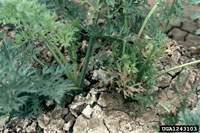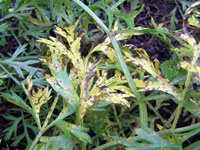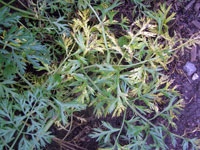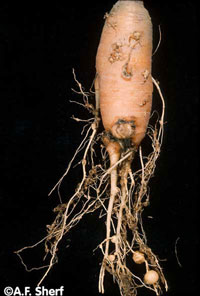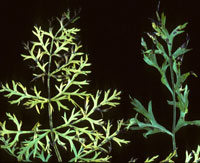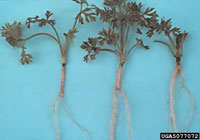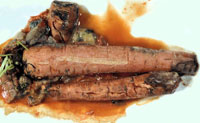Extension > Garden > Diagnose a problem > What's wrong with my plant? > Vegetable > Carrot > Yellow, purple or red leaves
Carrot > Leaves > Yellow, purple or red leaves
1 of 6
Aster yellows
Aster Yellows Phytoplasma
- Older leaves first yellow, then turn a reddish-purple
- Leaves may become twisted
- New leaves are small, weak, pale and clustered in a short bunchy top
- Numerous hairy secondary roots develop in lines along the root
- Carrot has a bitter taste and may be off color
- Infected plants are scattered randomly through the field, and may flower in year one
- More information on Aster Yellows
2 of 6
Cercospora leaf blight
Cercospora carotae
- Leaves develop roughly circular purplish brown spots with a gray center
- Leaf tissue around spots turns yellow, leaf margins may darken and curl upward
- Many leaf spots can grow together resulting in leaf wilt and death
- Lesions apparent throughout old and new leaves
- Roots are not directly infected, but may be small due to severe leaf damage
- More information on Cercospora Leaf Blight
3 of 6
Northern root knot nematode
Meloidogyne hapla
- In severely infected plants, carrot tops may be stunted, yellow, and wilt during the day
- Tap root is stunted, deformed, or forked
- Many fibrous roots may be present
- Many small round to irregular lumps and swellings can be found on both the tap root and fibrous roots
- More information on Northern Root Knot Nematode
4 of 6
Bacterial leaf blight
Xanthomonas campestris pv. Carotae
- Leaf spots start small, circular, light brown to tan
- Eventually spots become elongate; dark brown with yellow edges
- Infection progresses down the leaf
- Severely infected leaves, yellow, wilt and die
- Lower leaf surface is very shiny, and may be sticky in wet weather
- Young leaves can become distorted
- Roots are not directly infected, but may be small due to severe leaf damage
- More information on Bacterial Leaf Bight
5 of 6
Pythium root dieback
Pythium spp.
- Carrot root is short stunted and may be forked or misshapen
- Carrot top may yellow and wilt if root damage is severe
- Horizontal lesions (1/10 cm to 1 cm) may appear on the surface of the root
- Common in heavy wet soils and organic soils
- More information on Pythium root dieback
6 of 6
Bacterial soft rot
Erwinia carotovora subsp. Carotovora
- Rotted sections of the root may dissolve into liquid when carrots are pulled
- Dark sunken, soft mushy cavities may form in the root
- Eventually part or all of the root becomes soft, watery, and slimy
- When root damage is severe, leaves turn yellow and wilt
- A foul odor may be present with the rot
- Common in very wet heavy soils
- More information on Bacterial soft rot



